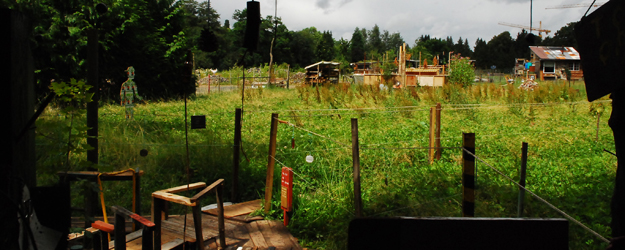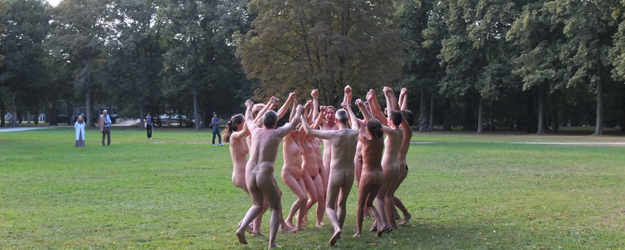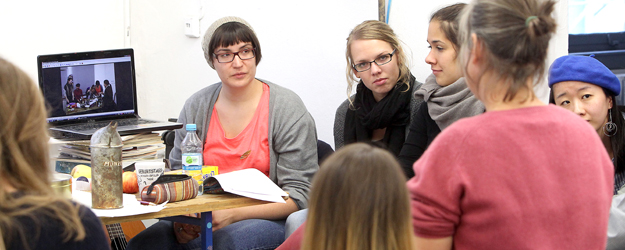19 November 2012
Nine students from the Mainz Academy of Fine Arts took part in the dOCUMENTA (13) exhibition. Professor Andrea Büttner was the driving force behind the initiative. She arranged that her students from Johannes Gutenberg University Mainz (JGU) were invited to serve as artistic assistants to Canadian Gareth Moore at one of the world's leading exhibitions of contemporary art.
A narrow path leads through a small forest, with dead vegetation lining the way to a unique village: "A Place Near the Buried Canal" is what artist Gareth Moore calls his installation. The Canadian artist has created huts, two museums, and a guest house from trash and all manner of found materials. Wooden paths wind through his refuge in Kassel's Karlsaue Park. This is his contribution to dOCUMENTA (13).
Yet anyone looking to explore the village will first have to pass the two students from the Mainz Academy of Fine Arts – and a donations can, welded together from an old tin and the spout of a watering can. "Visitors had to donate a coin," explains Frieda Nastold. "And they had to hand in their cell phones and cameras." Nadya Kim remembers the reactions to this: "Some were really quite furious about it, really angry."
A Place Near the Buried Canal
In a rear building in the city center, a steep staircase leads to Professor Büttner’s drawing class. The room has a workshop feel. There's much here that resembles Moore's village: the electric stove, for example, with its hopelessly rusted hobs, the sitting area composed of mattresses that have been pushed together – and the donations can standing on the table between the students. As a thank you for the support he'd been given, Moore sent a package containing items from his A Place Near the Buried Canal project to Mainz. The can was one of the items included.
Nine art students of Mainz University traveled in June 2012 to serve as artistic assistants at the 13th edition of the dOCUMENTA exhibition in Kassel. "I exhibited there and thought it would be terrific if our students could be there too," Büttner says. She made contact with the international Academy Network of the dOCUMENTA (13) and arranged for her students – as the only students from a German university – to participate in this flagship exhibition of contemporary art.
A small academy in a children's hospital
"We lived in Kassel," tells Nastold. "In a former children's hospital. It was like a small academy in and of itself." The students from Mainz met with some 100 students from places like Geneva, Helsinki, Malmö, and London. "There were lectures on a huge range of topics and a seminar program once a week."
"The deal was that the students would work for four hours a day and in exchange could attend any events," Büttner explains. She arranged that her students were assigned to Moore, as she knew he would have plenty for them to do. The Canadian artist himself had arrived in Kassel a year and a half earlier to begin constructing his village bit by bit.
A museum for Clara the rhino
"He totally adapted himself to the location," Nastold reports. His A Place Near the Buried Canal was in fact positioned quite close to the site of a planned but never constructed canal in the Karlsaue Park. And one of the huts he constructed, the Museum of Rhinoceros Clara, referenced a historical anecdote. In the 18th century a tame Indian rhino named Clara was shipped to Europe as a marvel. For 17 years the animal toured through Europe, drawing crowds as it went. The Karlsaue Park in Kassel was one of its stops. The village represented a memorial to this.
Naturally the students did more than just collect cell phones, cameras, and coins at the entrance to the village. They guided visitors along the footbridges and repaired damaged items. "We were able to experience how Moore works," explains Irina Konyukhova," and we talked with him about our own work. The best thing was that we always had the opportunity to talk with artists."
A Naked Nature Performance
The students took part in a wide range of activities, including the Naked Nature Performance staged by the Australian Stuart Ringholt, during which the volunteers danced naked through the landscape. Nastold shows pictures of this. "He takes an unbelievable delight in the naked body," she says in reference to Ringholt's art.
"The dOCUMENTA exhibition brought the whole city to life," claims Kim. And the Mainz students were much more deeply immersed in that vitality than normal visitors, who in some cases struck the students as quite odd. "We had a few very aggressive situations. We got screamed at once and we sometimes had to speak very sharply with people to keep them from breaking things. There were also people who were very impatient and wanted to see everything in one day."
A head full of art
That's quite impossible at the dOCUMENTA exhibition. The students for their part did have the chance to see and experience many things. They were there for 50 days in all. "By the end our brains were full and we couldn't absorb any more," Nastold remembers. "But that was a good thing."
"Right now we're contemplating what kind of follow-up work we're going to do for all of this," Büttner says. "How we can keep it alive and formulate what we've taken in. It could take the form of a book, an exhibition, or a joint project with other participants."
Something will be preserved, that much is clear. The collection can on the table is one sign of that. It's a rusty piece, welded together from rubbish. But it represents "A Place Near the Buried Canal” – a place that isn't likely to be forgotten anytime soon in the workshop room of the Mainz Academy of Fine Arts.



